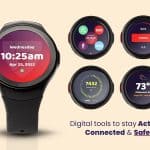
Wearable technology, like smartwatches, can monitor more than just your daily steps
When you think of wearable medical devices, you might think that these watches, pendants, or rings aren’t for you. However, more and more caregivers, both professional and family, are using wearable medical devices to help them take better care of themselves and their patients. We’ve pulled together a list of the latest tech trends that you can use in your professional life and in your personal pursuits as well. Even better, both you and the person you care for can benefit from using technology in these ways.
Smartwatches
While a fitness tracking watch that measures your steps were all the rage a little over a decade ago, the watch has come even further thanks to a bit of creativity, innovation, and technology. Today, your personal smartwatch can not only measure your steps to ensure you are staying physically active, but it can also tell you if you are sleeping well, if you should drink more water, and if you are washing your hands long enough.
If you haven’t updated your smartwatch in the past 4 years, you don’t know what you are missing! Today’s Apple Watches and other smartwatch offerings can be a crucial ally in your health goals. Measure your heart rate, oxygen saturation, and more with a quick tap on your watch screen. Then, share the information with your physician or just use it as you learn more about how your body works.

The right wearable device can help you and the person you care for get moving to your wellness goals
Using a smartwatch can benefit professional and family caregivers who are notoriously bad at keeping up with their own health needs. You can use your smartwatch to help remind you when you’ve been sitting too long and to help you take measured breaths in stressful situations.
As for the person you are caring for, they can benefit from wearing a smartwatch too. Today’s watches come in a variety of sizes and styles, ensuring they will be able to see the content on the display as well as use the device easily.
They can use their watch to:
- Set alarms or reminders for when it is time to take medication
- Monitor their whereabouts thanks to GPS capabilities
- Communicate via text or phone call without having to keep track of where their phone is at the moment
- Keep their physician updated on their heart rate, oxygen saturation, and other vital signs
- Remind them to get up and get active throughout the day
- Monitor falls thanks to fall detection technology that notes any fall-like behavior and sends a message to the user asking if they need emergency response
Other Wearable Devices
Of course, wearable technology is not just reserved for watches. In fact, devices like the Oura Ring can measure your body temperature, daily fitness, sleep habits, calories burned, respiratory rate, and more. Similarly, the Whoop bracelet is designed to help you recognize how your body recovers as a part of its fitness journey.
You don’t need to use a smartwatch to get insights into your body and health. Instead, you can find another way that suits your style, preferences, and budget.
For those you care for, other wearable options might be best if they don’t necessarily like wearing a watch or if their physician is looking for more in-depth information before, during, or after a diagnosis or procedure. For example, the BioIntelliSense wearable device is a sticker that is meant to monitor vital signs continuously for 30 days before needing to be replaced. They have also recently introduced a BioButton that monitors for health and screens for COVID-19, demonstrating how the sky is the limit when it comes to what wearable devices can tell us and our physicians.
Voice Assistants
While you can’t exactly wear your Google Home or Alexa device, you can pair it with your smartwatch or just use it while it is perched on your kitchen counter. Voice assistants have proven to be a key tool for organization, and when you use them effectively, you can end up feeling less stressed.
You can use your voice assistant to:
- Set a reminder for medications
- Make a to-do list or grocery list that you can pull up at any time
- Listen to a favorite song
- Learn trivia questions or jokes to share with the person you care for
- Listen to an audiobook or podcast alone or with the person you care for
- Control the lighting in the home so you can decrease the risk of falls
- Make a quick phone call or check in with someone via a voice message
- Use smart locks or smart plugs to automate certain tasks throughout the home
There are plenty of features you can use at home or in the home of the person you care for. It just takes a bit of exploring and asking the right questions.
Wellness Apps
As we all know, there is an app for almost anything these days. If you are looking for ways to decrease stress, start a meditation habit, pull up a workout for your gym session, or keep track of the medications your loved one takes, you can find an app for that too. Here are just a few you might use on your own or with the person you care for:
- Headspace, an app to help you meditate, relax, or sleep
- Lumosity, an app full of brain games that help you stay sharp and engaged
- Medisafe, an app to keep medications and schedules on track
- Silver Sneakers GO, an app that makes fitness fun and approachable for older adults
- Be My Eyes, an app that connects low-vision people with sighted volunteers for visual assistance
Smart Clothes
While the smart clothes industry is still relatively new, we are learning that this trend could quickly become a must-have in the next few years. Companies like Loomia are starting to explore the connection between electric circuits and everyday products that could help wearers monitor body temperature or even take real-time vital sign monitoring.
Wearable technology is an industry that is growing every year, creating new opportunities to support caregivers and their loved ones. Compare the costs of wearable technology with the costs of traditional medical alert devices to see what is right for you. You can review the Life Alert cost versus other offerings right on our site.


